|

Comparison of variants of the
Nodong/Shahab missile with the first stage of the Safir launch vehicle
and its further development
Some important notes from the available imagery for a more accurate
interpretation of the Safir launcher:
-
The only way to make statements about
the used fuel combinations and their mixing ratios are more or less
good photos. This affects of all rockets, beginning with Shahab-3 and
ending with Safir-1B IRILV. The most important criterion was to find
the location of an intertank section.
-
On a detailed photo of the Safir-0
rocket (mockup) is visible - about in the middle of the first stage
- a hatch, which indicating the position of the intertank section.
-
The slightly longer tank for the oxidizer
is located in the top part of the rocket, therefore the tank for the
fuel in the lower part (in contrast to Shahab-3 and Ghadr-H).
-
Due to the unexpected length of the
fuel tank is kerosene not into consideration, it should be UDMH.
-
On a rare photo of the refueled Safir-Omid
a temporary insulation of the fuel tank is visible. For Kerosene is
such insulation not required.
-
The Safir-0 has probably a small additional
tank, which is located beneath the fuel tank. It is detect the typical
red marked inlet for oxidizer.
-
This small extra tank was removed
from the Safir-1, Safir-1A and Safir-1B in favor the extension the fuel
tank and thus the change of the
volume mixing ratio of 1.50 after 1.10.
-
The different length of the cable
ducts between Safir-0 and Safir-1/1A/1B documented these observations.
-
It is believed that the small additional
tank was filled with oxidizer of better quality than AK-27 (N2O4 ?).
Obviously this oxidizer (N2O4 ?) now used for the entire filling of
oxidizer tank (Safir-1A/1B).
-
Now the permanent brown plume is not
present at the nozzle. This is also true for the Ghadr-TR test rocket.
-
Appropriate announcements about a
new "high energy fuel" are known from Iranian source. The thrust of
the engine is increased from 314 to 348 kN (vac).
-
The Safir-1/1A/1B have minor fins
to reduce the launch weight of the rocket, for the Safir-1B even the
paint is omitted.
-
These findings (UDMH/AK-27 as propellant
combination) can we transferred to the Nodong missile and their variants,
because they use the same engines.
-
On photos of maneuvers is to see that
the Shahab-3 missile to be refueled on-site, in contrast to the Shahab-2
(Scud) missiles.
-
The intertank sections of Shahab-3
and Ghadr-H are at the same height above the ground. The oxidizer tanks
therefore have the same length. The fuel tanks above are of different
lengths. The fuel tank of the Ghadr-H is about 2.0 m longer.
-
Therefore the volume mixture ratios
of Shahab-3 and Ghadr-H with 1.90 and 1.15 are significantly different.
-
Since both missiles use the same Nodong
engine, they likely to take the same fuel combination, probably UDMH/AK-27.
The volume ratio of 1.90 for the Shahab-3 however speaks for the combination
TM-185/AK-27.
-
The pipe connections for fuel and
oxidizer, at the lower end of the tank, are differently positioned between
and Safir-1 and Ghadr-H.
See below.
|
| Shahab-3
missile and variants |
|

Shahab-3 and Ghadr-H in comparison
(both without extra tank sections)

Intertank sections with maintenance
hatch
|

Shahab-3 with large fins

Ghadr-TR with small fins

Ghadr-1 with small fins
|
|

Refueling on-site ensures stable
temperature conditions for the fuel
|
| Safir-0
launcher and evolution |
|

Safir-0 (Paektusan-2) with large
fins
|

Safir-0 (Paektusan-2) with extra
tank section
|
|

Safir-0 vehicle: To seen is the
intertank section with maintenance hatch
|


Safir-0 vehicle with wrong painting
for show
|
|

Safir-0 on pad: Containers for propellant
in the foreground
|

Safir-0 on launch pad
|
|
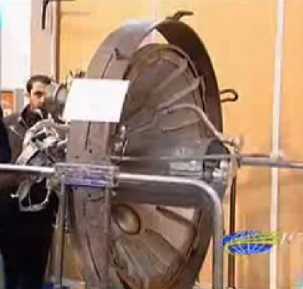
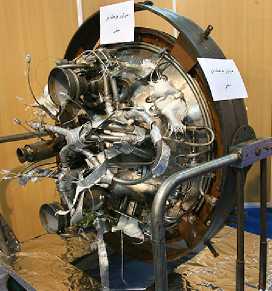
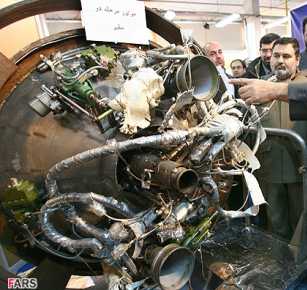
Safir-0 Second stage engine
arrangement
|
Safir-0
(Paektusan-2) details
|
|
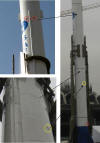
|
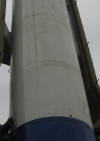
|
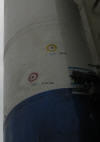
|
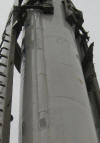
|
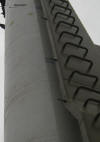
|
|
Main oxidizer Tank
on top
|
Oxidizer extra
tank section
|
Fuel drain & extra
oxidizer valve
|
Maintenance hatch
|
Maintenance hatch
& fuel valves
|
|
| Safir-1
launcher and evolution |
|

Safir-1 (Omid) with small fins and
longer cable duct
(extra tank section is absent)
|

Safir-1A and Safir-1B with small
fins, double hatch and longer cable duct
(extra tank section is absent)
|
|



|
| |
|

|

|
|
The pipe connections
for fuel and oxidizer, at the lower end of the tank, are differently positioned
between Safir-1 (left) and Shahab-3 (right)
|
|

Upper part of the first stage with
adapter
|

Bottom of the first stage oxidizer
tank (?)
|
|

Safir-1A engine bay unit with double
hatch
|

|
|

The Nodong engine and its dimensions
|

The Safir engine on the test stand
|